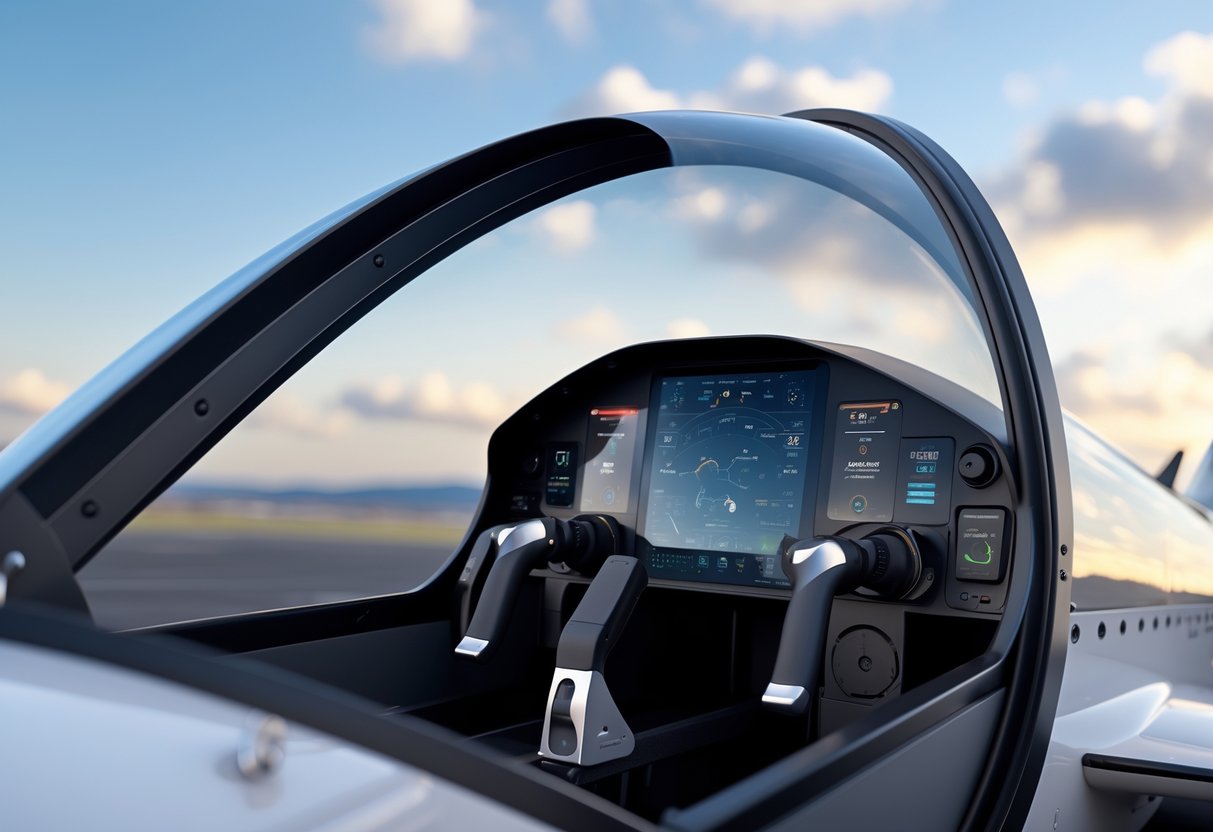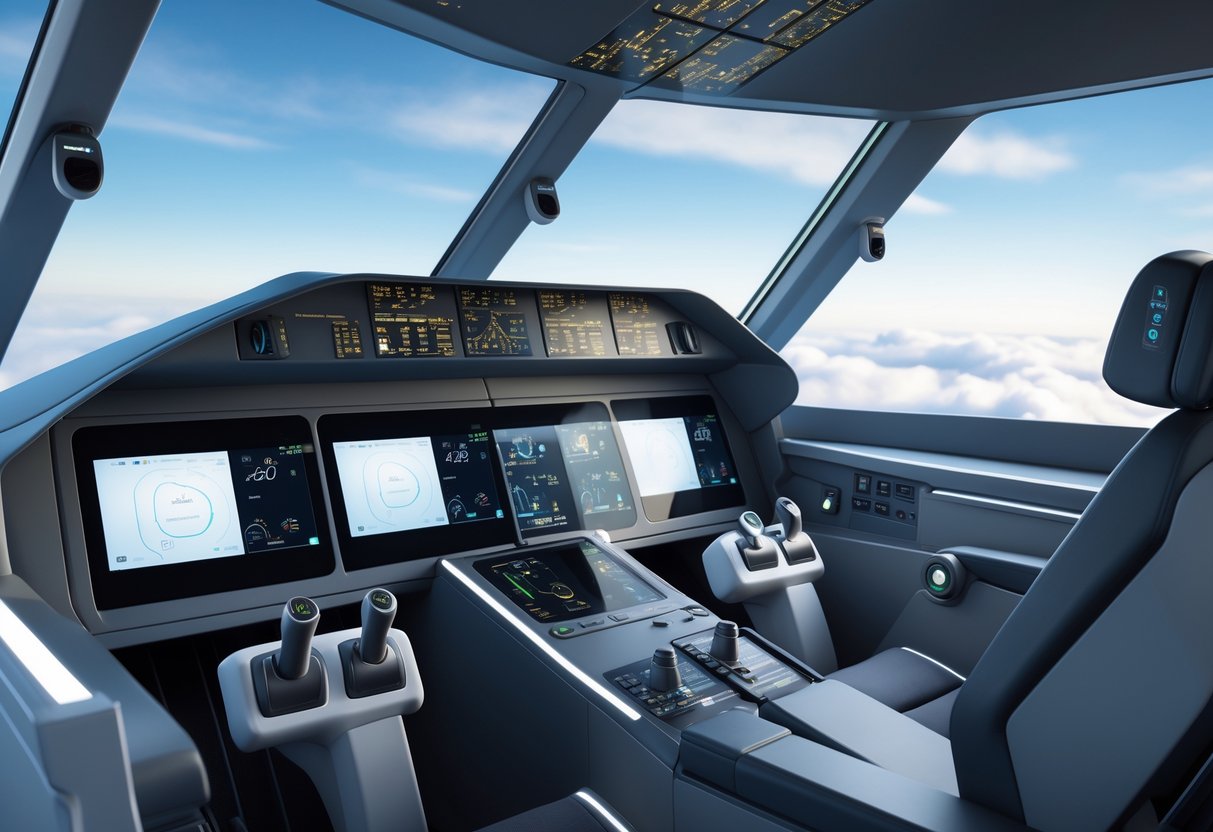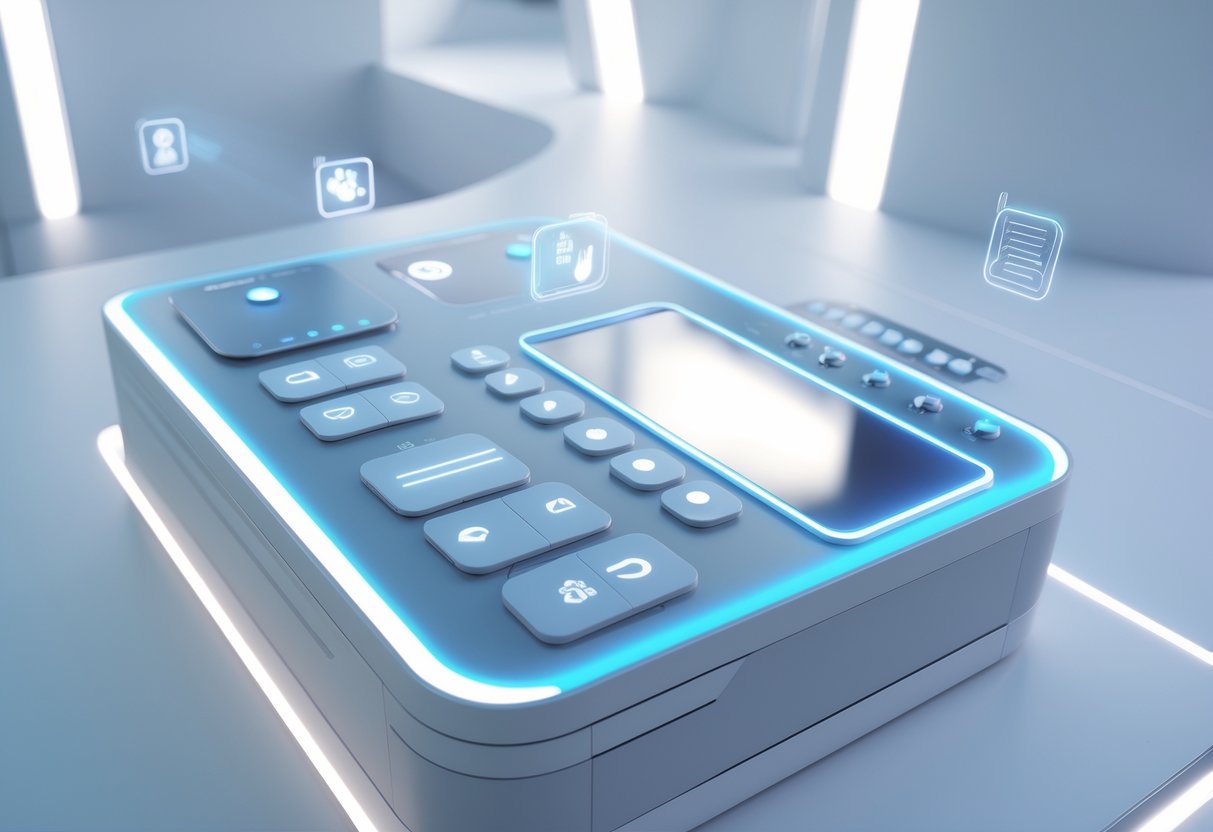Simplified Controls: Revolutionising Modern Aircraft Usability
Updated On: November 13, 2025 by Aaron Connolly
Understanding Simplified Controls
Simplified controls cut down the complexity of old-school flight systems by automating routine stuff and giving pilots a cleaner, more intuitive interface.
These systems aim to make flying feel more natural, but they still keep things precise and safe.
Definition and Core Principles
Simplified controls mark a pretty big shift from the old manual flight decks to automated, user-friendly setups.
We build these systems around three main ideas that open up flying to more people.
Automation Integration
These controls take over routine flight chores automatically.
The system manages basics like altitude and heading, so pilots don’t have to keep fiddling with every little thing.
Interface Streamlining
We trim down the number of switches, buttons, and separate displays.
Key flight info pops up on integrated screens, not scattered across a dozen gauges.
Intuitive Operation
Controls react the way you’d expect—pull back to climb, push forward to descend.
The system turns these simple moves into the complex actions the plane needs.
This tech pulls away layers of old complexity between what the pilot wants and what the plane does.
Pilots used to juggle multiple control surfaces, but now the system coordinates all that automatically.
Comparison with Traditional Flight Controls
Traditional flight controls put a heavy load on pilots.
They need tons of training and have to keep an eye on several systems at once.
Pilots used to manually coordinate rudder, elevators, and ailerons while watching a sea of instruments.
Training Requirements
Old systems require hundreds of hours just to get comfortable.
Pilots have to learn each gauge and switch on its own.
Simplified controls cut that training time way down.
Workload Differences
Conventional setups force pilots into constant adjustments.
You’ll see this in older planes where pilots are always trimming and watching engine readings.
Error Prevention
Manual controls leave more room for mistakes since pilots have to coordinate everything themselves.
Simplified systems block a lot of common errors by automating risky input combinations.
Modern tech tries to balance manual control and full automation.
Pilots still make the big calls, but the system handles the mechanical grind.
Key Components and Interfaces
Simplified flight controls rely on integrated displays and smart input devices instead of old levers and knobs.
We design these systems with specific pieces that all work together.
Primary Flight Display (PFD)
This screen puts altitude, speed, heading, and attitude info together.
Traditional cockpits scatter this data everywhere.
Multi-Function Displays (MFD)
These touchscreens handle navigation, weather, and system checks.
Pilots get to everything through simple menus instead of hunting for physical switches.
Fly-by-Wire Systems
Computers move the control surfaces based on what the pilot wants.
The system blocks dangerous attitudes, but still listens to the pilot’s commands.
Integrated Autopilot
Modern controls come with autopilot you can activate with a single button.
Pilots set altitude or heading right from the same screen they use for manual flying.
All these interfaces link up through digital networks, not clunky mechanical rods.
That way, info moves instantly between components and responses stay consistent.
How Simplified Controls Operate
Simplified controls use advanced automation to take care of complex flight tasks.
Pilots can focus on basic path commands instead of sweating the small stuff.
The system blocks dangerous situations with built-in safety features.
Pilots always have a quick way to end the flight safely if needed.
User Input and Automation
Simplified controls really change how pilots interact with their planes.
Instead of micromanaging each surface, pilots just tell the plane where to go.
A pilot might tap “takeoff” on a screen or nudge a control to pick a direction.
Automation takes care of all the complicated stuff in the background.
Advanced automation handles things like:
- Power management
- Control surface tweaks
- Speed control
- Navigation
This approach drops the pilot workload a ton.
Pilots go from juggling multiple controls to just focusing on one main input.
The system uses flight envelope protection to keep things safe.
It won’t let pilots accidentally push the plane into dangerous situations.
Even if a pilot tries something risky, the automation steps in and blocks it.
The aircraft stays within its safe limits, no matter what.
System Architecture
Sophisticated automation sits at the heart of simplified controls.
You’ll find similar tech in big airliners, but now it’s showing up in smaller planes too.
Flight envelope protection forms the foundation.
It blocks the plane from going too fast, too slow, or getting into weird attitudes, no matter what the pilot does.
The system includes:
- Automated power management
- Flight path control
- Speed regulation
- Altitude management
| Traditional Controls | Simplified Controls |
|---|---|
| Multiple instruments | Single interface |
| Manual power control | Automated power |
| Direct surface control | Path-based commands |
| Pilot monitors everything | System monitors limits |
Aircraft automation steps in during emergencies.
If an engine fails, the system automatically adjusts to keep the plane flying safely.
Pilots don’t have to memorize complex emergency checklists.
Automation handles the technical stuff and keeps pilots in the loop.
Override and Safety Functions
Every simplified control system needs a quick way to end the flight safely.
This “discontinue flight” button acts as the ultimate backup.
When you hit it, the system can:
- Land right away
- Head back to the airport you left
- Divert to the nearest safe spot
- Circle until things get better
The system blocks accidental activation, so you can’t just bump the button and trigger an emergency.
Flight envelope limits stay active even during emergencies.
The plane won’t break its safe parameters, no matter what automated response kicks in.
Pilots still get to steer the general path.
But the automation won’t let anyone do anything unsafe.
You end up with several layers of protection.
The main automation prevents problems, backups handle failures, and the discontinue function is always there as a last resort.
Technological Foundations of Simplified Controls

Modern simplified controls depend on three big tech pillars.
Touchscreens replace old buttons and switches, single joystick systems put everything in one hand, and advanced software with sensors keep things running smoothly in the background.
Touchscreen Interfaces
Touchscreens have totally changed how we interact with control systems.
Now, one screen can replace dozens of physical buttons.
Menus and options switch up based on what you need at the moment.
During takeoff, you might see engine tools; during cruise, navigation pops up.
The main perks:
- Way fewer physical controls to memorize
- Menus that change to fit the situation
- Visual feedback so you know your input worked
- Easy updates through software, not hardware
Flight control tech uses these screens to group similar functions.
Instead of hunting across a huge panel, everything you need is right in front of you.
Single Joystick Systems
Single joystick systems put several controls into one stick.
Airbus Helicopters came up with a system where one joystick runs the whole show.
Old planes needed separate levers for pitch, roll, yaw, and power.
A single joystick system combines all that with different moves and button presses.
The joystick responds to:
- Forward/back for pitch
- Left/right for roll
- Twisting for yaw
- Buttons for extra stuff
This setup drops pilot workload a lot.
New pilots pick it up faster since there’s only one main control.
Experienced pilots make fewer mistakes since everything’s within reach.
Software and Sensors
Advanced software and sensors are the brains behind simplified controls.
They monitor hundreds of things every second and tweak settings automatically.
Automation takes care of routine stuff so pilots don’t have to.
Software can spot problems early and either fix it or let the pilot know.
Sensors constantly measure speed, altitude, temperature, and engine performance.
Key features:
- Automatic stability tweaks
- Predictive maintenance alerts
- Real-time monitoring
- Error prevention systems
Sensors back each other up.
If one fails, others fill in—so the system keeps running safely.
This redundancy makes simplified controls more reliable than old manual setups.
Automation takes over the boring, repetitive tasks.
Pilots can focus on making decisions and handling surprises.
Advantages of Simplified Controls in Modern Aviation

Simplified controls make flying less stressful and safer.
Pilots don’t have to sweat every little detail and can focus on bigger decisions.
Reducing Pilot Workload
Old cockpits bury pilots in switches and gauges.
Simplified controls let computers handle routine flying.
Aircraft automation keeps altitude and speed steady.
Pilots don’t have to make constant tiny corrections.
The computer holds the plane stable, so pilots can focus on where to go and who to talk to.
Flight management gets easier with touchscreens.
Instead of memorizing which switch is which, pilots tap a button or use voice commands.
Honestly, it feels more like using a smartphone than an old clunky computer.
Modern systems juggle several tasks at once.
The computer can manage power, adjust flight path, and keep an eye on the weather—all at the same time.
Pilots get to concentrate on the big stuff, not a million small things.
Training is way faster.
New pilots get the hang of these systems much quicker than the old ones.
They spend less time memorizing layouts and more time learning how to actually fly.
Enhanced Safety Features
Flight envelope protection keeps planes out of dangerous situations.
If a pilot pulls too hard, the system steps in and corrects things.
It won’t let the plane stall or make turns that are too sharp.
Even when pilots mess up or emergencies hit, the protection’s still there.
Automated systems keep an eye on dozens of sensors at once.
They catch problems faster than any human could.
If something’s wrong, the computer lets pilots know right away and suggests what to do.
Emergencies are easier to handle now.
Pilots can tell the plane to land itself instead of wrestling with every control.
That’s a real lifesaver if someone gets sick or the weather turns nasty.
Collision avoidance is built in, too.
Systems watch for other planes and obstacles, warn pilots, and can even act automatically if needed.
You get multiple layers of protection you just don’t see in older aircraft.
Regulatory Developments and Certification Pathways

The FAA’s MOSAIC rulemaking is shaking up how aircraft get certified.
They’re streamlining special airworthiness processes and leaning more on industry standards.
FAA and MOSAIC Rulemaking
The Modernisation of Special Airworthiness Certification (MOSAIC) Notice of Proposed Rulemaking (NPRM) brings big changes to how aircraft get certified.
This new framework lets more types of aircraft use simplified certification.
MOSAIC expands the light-sport aircraft category past the old weight and speed limits.
The new rules bump the max takeoff weight up to 3,000 pounds and allow higher stall speeds.
Key MOSAIC Changes:
- Higher weight limits for light-sport planes
- More passengers allowed
- Night and instrument flight now on the table
- Retractable gear gets the green light
These changes tackle old rules that kept general aviation from moving forward.
Final rules should land in the next couple of years after the comment period wraps up.
Modernisation of Special Airworthiness Certification
Special airworthiness certification is getting streamlined to cut down on red tape but still keep things safe.
The FAA is shifting to performance-based rules instead of strict checklists.
Old certification needed piles of paperwork and long waits.
Now, the focus is on industry standards and letting qualified manufacturers self-certify.
Certification Categories Getting Updated:
- Experimental aircraft
- Light-sport aircraft
- Amateur-built planes
- Primary category aircraft
Manufacturers can now prove they comply using recognized consensus standards, like those from ASTM International.
These changes slash certification time from years to just months for some aircraft.
Manufacturers should see big cost savings when chasing special airworthiness certificates.
Industry Consensus Standards
Industry consensus standards are quickly becoming the backbone for easier aircraft certification. ASTM International leads the charge on these technical standards for light-sport and experimental aircraft.
These standards lay out airworthiness requirements, manufacturing quality assurance, and maintenance procedures. They give manufacturers clear technical specs but still leave plenty of room for design creativity.
Primary Standards Organisations:
- ASTM International: Light-sport aircraft standards
- SAE International: Aerospace systems standards
- RTCA: Aviation electronics standards
- EUROCAE: European aviation standards
Consensus standards let manufacturers skip the endless case-by-case regulatory debates. If they show compliance with the published standards, they get much faster certification.
International teams work to harmonise these standards across aviation authorities. This helps manufacturers meet consistent requirements worldwide.
Applications in Light-Sport Aircraft and Beyond

The MOSAIC rule now brings simplified flight controls to more aircraft types, not just light-sport planes but also helicopters and powered-lift vehicles. These systems fit into more complex aircraft, but they stick to the same core automation ideas.
Light-Sport Aircraft Eligibility
Under MOSAIC, light-sport aircraft can use simplified flight controls and still keep their LSA certification. This is a big change from the old manual control requirements.
Now, LSA manufacturers can install fully automated flight systems. Pilots interact with touchscreens, buttons, and simplified interfaces instead of traditional yokes or sticks. The computer automatically manages altitude, speed, and navigation.
Key LSA Features with Simplified Controls:
- Four seats in airplanes (two seats in other LSA types)
- Automated stall and spin prevention
- Touch-screen flight management
- Emergency landing automation
Sport pilots can fly these aircraft after model-specific training. Each system needs a separate endorsement from a qualified sport pilot CFI. The training focuses on automation management, not stick-and-rudder skills.
These systems block dangerous flight regimes, no matter what the pilot does. If there’s an emergency, pilots can command an immediate landing or diversion, all without manual control.
Integration into Helicopters and Powered-Lift
MOSAIC brings simplified controls into the world of light-sport helicopters and powered-lift aircraft. This change really opens things up for eVTOL development.
Powered-lift aircraft especially benefit during those tricky transitions between vertical and horizontal flight. Automation takes over the complex stuff, while pilots just set the desired flight profile.
Helicopter Applications Include:
- Automated hover stability
- Simplified landing procedures
- Emergency autorotation assistance
- Obstacle avoidance systems
These aircraft use Simplified Vehicle Operations (SVO) to keep things stable in specific flight conditions. The system always monitors flight parameters and steps in to prevent loss of control.
Electric aircraft makers can now design simplified control systems for urban air mobility. Passengers practically become operators, just telling the system where to go.
Retractable Landing Gear and Propeller Controls
Now, simplified flight controls work with retractable landing gear and controllable speed propellers in LSA. These features were off-limits before.
Automation takes care of the gear—retracting and extending it at the right moments. Pilots don’t have to think about timing or sequencing; the system handles it and cuts down on gear-related mistakes.
Automated Systems Include:
- Gear retraction on takeoff
- Automatic extension for landing
- Speed-based propeller pitch adjustment
- Engine parameter optimisation
Controllable speed propellers adjust automatically for the best performance. The system picks the right pitch for takeoff, cruise, and landing. Pilots set the power, and automation handles the rest.
These upgrades blur the lines between traditional LSA and Part 23 airplanes. Manufacturers can offer more advanced aircraft, but sport pilot training requirements stay simple.
Impact on Pilot Training and Certification

The MOSAIC rule changes how pilots train for aircraft with simplified controls. Now, pilots need model-specific endorsements instead of old-school manual flying skills.
Sport pilots can fly these automated aircraft with fewer training hours. This specialised certification, though, doesn’t carry over to traditional pilot certificates.
Requirements for Sport Pilots
Sport pilots can fly aircraft with simplified controls after getting the right training and endorsements. The FAA says these automated systems can cut traditional training requirements by up to 50%.
That makes sense, since simplified controls handle most flying tasks. Instead of learning all the manual stick-and-rudder work, pilots focus on managing automation and giving the computer commands.
Still, pilots need proper certification. They have to complete ground school for the specific aircraft systems. The training is all about using touchscreens, buttons, and automated interfaces—not yokes and pedals.
Key training areas include:
- Understanding automated flight systems
- Learning emergency override procedures
- Practising command inputs through digital interfaces
- Studying aircraft-specific safety features
The sport pilot certificate stays as the entry point. But now, earning it is more accessible with simplified control aircraft.
Model-Specific Flight Training
Every simplified flight control system needs its own endorsement from a qualified sport pilot instructor. You can’t just hop between different automated aircraft without extra training.
Manufacturers run specialised training for their systems. If you train on one brand’s controls, you can’t fly another brand’s aircraft until you finish their course.
This keeps pilots sharp on each system’s unique interface and emergency procedures. Manufacturers use different automation levels and control methods, so one size doesn’t fit all.
Training components usually include:
- Ground instruction on the aircraft’s systems
- Simulator time with digital interfaces
- Flight hours with a certified instructor
- Endorsement testing on emergencies
Flight schools need instructors who are endorsed for each system they want to teach. These instructors get trained directly by the aircraft manufacturers.
Implications for Other Pilot Certificates
Experience with simplified controls doesn’t count toward higher pilot certificates that require manual flying skills. Commercial and airline pilot licenses still demand good old stick-and-rudder proficiency.
So, aviation training splits into two tracks. Sport pilots can fly highly automated aircraft with less training, but anyone aiming for a commercial career still needs to master manual controls.
This means:
- Simplified control hours rarely count for commercial certificates
- Traditional flight training is still required for airline jobs
- Sport pilots need more training to move up to private pilot certificates
- Flight schools may run both automated and manual training tracks
Some folks in the industry think this could slow down career growth for pilots who start with simplified controls. On the other hand, it’s a great way for more people to get into flying for fun without huge training commitments.
The FAA might let some simplified control experience count toward higher certificates in the future, but for now, the lines between automated and manual flying skills stay clear.
Role in General Aviation and Commercial Flying
Simplified flight controls are moving beyond light sport aircraft and changing how we fly in general aviation and commercial sectors. The tech lets sport pilots take on commercial tasks that used to be off-limits, and it’s paving the way for more automated flight operations.
Use in General Aviation
General aviation is getting a serious makeover thanks to simplified flight controls. The MOSAIC rule allows these systems in light sport aircraft that are heavier than the old limits.
Right now, you can find helicopters and powered-lift aircraft with tablet-like interfaces. Skyryse, for example, has shown off simplified controls in Robinson R44 helicopters, using automation to prevent loss of control.
The technology adds flight envelope protection like you’d see in airliners. This stops pilots from putting the aircraft into dangerous situations, no matter what they try.
Key features for general aviation:
- Automated flight path management
- Built-in safety systems that override risky commands
- Emergency discontinuation for quick landings
- Model-specific training for each aircraft
Pilots need special training and logbook endorsements for each simplified control aircraft they fly, no matter their certificate level.
Increased Pilot Privileges
With simplified controls under MOSAIC, sport pilots get a bunch of new privileges. We can now fly aircraft with advanced automation that used to be out of reach.
Night operations are now possible for sport pilots using simplified control aircraft. Automation gives safety margins that manual controls just can’t match at night.
Instrument flight rules operations are allowed with the right simplified control systems. Automation manages the tricky instrument procedures and keeps the flight envelope protected.
New aircraft access includes:
- Light sport helicopters with simplified controls
- Four-seat aircraft (with some passenger limits)
- Multi-engine aircraft with automated systems
- Powered-lift designs in the future
Each new privilege comes with its own training and endorsements. Sport pilots can’t transfer endorsements between aircraft models, so they need to know each system well.
Commercial Operations and Aerial Applications
Simplified flight controls open up commercial opportunities that used to require higher pilot certificates. Aerial photography is now something sport pilots can do, as long as the aircraft is properly equipped.
Pipeline patrol and agricultural surveys are two areas growing fast with simplified controls. Automation lightens the pilot’s workload and keeps flight paths precise for these jobs.
Commercial applications now allowed include:
- Agricultural monitoring and spraying
- Real estate photography
- Infrastructure inspection flights
- Environmental survey operations
The tech really shines in aerial photography. Pilots can focus on the camera while the aircraft holds position and altitude automatically.
Training is still strict for commercial ops. Pilots need both the simplified control endorsement and the right commercial training for their missions.
There are cost benefits, too—less training time and lower insurance premiums thanks to the safety systems. But each aircraft model still needs separate certification and training.
Design Considerations for Aircraft with Simplified Controls

Designing aircraft with simplified controls means finding the right balance between automation and pilot oversight. These systems have to fit in smoothly with existing aircraft systems and meet tough safety standards.
Aircraft Design Standards
The FAA’s MOSAIC rule sets specific requirements for simplified flight controls. The standards focus on keeping aircraft out of dangerous situations like stalls and spins.
Aircraft need envelope protection systems that automatically block unsafe flight conditions. Pilots can’t override these safety limits.
Control interfaces swap out traditional yokes and pedals for touch screens, buttons, and knobs. Each interface should be intuitive and clearly labeled.
Flight management systems now handle navigation and flight planning. Pilots enter a destination, and the system figures out routes and altitude changes.
Redundancy requirements are tougher than before. Critical systems need backups—sensors, computers, and control surfaces all get extra layers of protection.
Integration with Aircraft Systems
Simplified flight control systems have to play nicely with all the other aircraft systems. The flight control computer links up with engines, navigation, and safety systems.
Data sharing is a must. The autopilot pulls engine data to keep the speed right. Navigation systems feed position info to flight controls for accurate routing.
Emergency procedures are now automated responses. If smoke appears in the cabin, pilots can order an immediate landing—no manual flying needed. The system manages descent and approach automatically.
Power management ties into flight controls for electric aircraft. Battery levels affect planning and landing decisions, and the system adjusts routes based on remaining juice.
Communication systems hook into air traffic control through the same simplified interface. Pilots get clearances and weather updates on the same screens they use for flight control.
Future Trends and eVTOL Innovation

The eVTOL industry is moving at a breakneck pace—from wild concepts to real, flying aircraft people will actually use. Big companies are already testing air taxis, and some cities want flying vehicles in the skies by 2026.
Electric Vertical Takeoff and Landing Adoption
We’re actually seeing eVTOL aircraft go from test flights to commercial use as early as 2025. Companies like Joby Aviation and Lilium have wrapped up years of testing and are now prepping for passengers.
The tech behind these aircraft has come a long way. Batteries last longer and weigh less than before. Electric motors are more reliable and need less maintenance than traditional engines.
Key adoption milestones happening now:
- First commercial routes launching in Dubai and Singapore
- Safety certificates getting approved by aviation authorities
- Pilot training programs starting at flight schools
- Airport infrastructure being built for eVTOL landings
Battery life remains the biggest challenge. Most eVTOLs can only fly 20–30 minutes before they need a recharge. That really limits their range compared to helicopters or small planes.
Manufacturers are ramping up production fast. They’re building factories to make hundreds of aircraft per year, not just a few prototypes.
Urban Air Mobility Developments
Cities are rewriting their rules and changing up infrastructure to welcome flying taxis. Builders have started putting up dedicated landing pads, or vertiports, on rooftops and close to busy transport hubs.
Air traffic control systems face a big challenge—they need a serious upgrade to safely manage thousands of eVTOL flights. New computer systems now track low-flying aircraft automatically, so not every flight needs a human controller watching over it.
Urban infrastructure changes include:
- Vertiports at airports, hospitals, and city centres
- Charging stations for electric aircraft
- Noise monitoring systems in residential areas
- Emergency landing zones along flight paths
London, Paris, and a few other big cities have started testing flight corridors for eVTOL aircraft. These routes usually follow rivers and highways, keeping flights away from crowded neighborhoods.
People are starting to warm up to the idea as they notice the benefits. Flying taxis skip traffic jams and can get you across the city way faster than a car during rush hour.
The price is still pretty steep—early rides cost about the same as a helicopter flight. Over time, though, as more aircraft show up and competition ramps up, prices should come down.
Expanding Use Cases
eVTOL aircraft aren’t just for carrying passengers anymore. Emergency services have jumped in, since these aircraft reach accident scenes much faster than ground vehicles.
Medical transport is quickly becoming a major use. eVTOLs can carry patients from accident sites to hospitals in just minutes. They also deliver blood, organs, and urgent medical supplies when time matters most.
Growing applications include:
- Emergency response: Police, fire, and ambulance services
- Cargo delivery: Same-day shipping for high-value items
- Tourism: Scenic flights and airport transfers
- Offshore operations: Servicing oil rigs and wind farms
Amazon and a few others are already testing eVTOLs for package delivery out in rural places. These aircraft handle heavier loads than regular drones and can fly much farther.
Military and security teams have started using eVTOLs too. They’re quieter than helicopters and can take off from tight spots, which makes them handy for surveillance and special missions.
The technology keeps getting better and more affordable for commercial use. As battery technology improves and factories produce at scale, we’ll see eVTOLs popping up in even more areas soon.
Challenges and Considerations

Simplified controls bring big advantages, but they also come with some tough challenges. We have to tackle safety concerns, the limits of simplified models, and shifting regulatory requirements.
Safety and Reliability Concerns
Safety always comes first when we roll out simplified controls for aircraft. We need to make sure that cutting complexity doesn’t weaken the aircraft’s ability to handle emergencies or weird situations.
Critical safety considerations include:
- Backup systems for simplified automated controls
- Pilot override capabilities in all simplified systems
- Comprehensive testing under extreme conditions
- Clear documentation of system limitations
Simplified controls can make pilots rely too much on automation. That’s caused problems in the past—crews have struggled when automated systems failed and they had to fly manually.
Training programs need to keep pilots sharp in both automated and manual controls. Regular simulation drills help crews stay ready for times when the fancy systems don’t work as planned.
Airworthiness standards demand that simplified control systems match or beat the safety of traditional setups. So, we have to test and validate these systems thoroughly before putting them in the air.
Model Limitations
Simplified control systems use mathematical models to mimic real aircraft behavior. These models work fine in normal situations, but they can miss some of the weird stuff that happens in actual flights.
Key model limitations include:
- Nonlinear flight dynamics at extreme conditions
- Environmental factors like severe weather
- System interactions not accounted for in simplified models
- Degraded performance outside design parameters
We often use linear models for control design, even though real aircraft don’t always behave so predictably. This usually works, but things can get tricky in emergencies or unusual flight conditions.
Aircraft certification now requires us to prove that simplified models hold up across all flight scenarios. We have to show these limits won’t put anyone in danger.
We keep validating models by comparing them against flight test data. This helps us spot where our simplified systems might fall short and gives us a chance to fix things.
Ongoing Regulatory Evolution
Aviation rules keep changing as technology moves forward. We have to design systems that meet today’s standards but also keep an eye on what’s coming next.
Regulatory considerations include:
- Certification requirements for new simplified technologies
- International harmonisation of standards
- Pilot training and licensing requirements
- Maintenance and inspection protocols
Different aviation authorities don’t always agree on how to approve simplified controls. When we design for global fleets, we have to work through these differences.
Getting regulatory approval for simplified controls can drag on for years. We need to plan ahead for certification steps and possible design tweaks.
Emerging technologies like AI in flight controls bring fresh regulatory headaches. Authorities are still working out how to evaluate these advanced systems.
We need to keep in close contact with regulators so we’re ready for new rules and can keep our systems in line for as long as they’re flying.
Frequently Asked Questions

People have a lot of questions about making controls easier and more user-friendly. These concerns cover everything from designing for all ages to cutting down the learning curve for new tech.
Could you explain how to make control interfaces user-friendly for all ages?
Start by figuring out what different people need. Older users usually like bigger buttons and clear, simple text. Younger folks pick up touchscreens and gestures quickly.
High contrast colors—like black text on a white background—work best. They help people with vision problems read labels and instructions without squinting.
Make your touchscreen buttons at least 44 pixels wide. That size fits both small fingers and larger hands. Space things out so people don’t hit the wrong button by accident.
Use both icons and text on buttons. Icons catch the eye, while text helps those who just want to read. Keep symbols simple and familiar.
Test your designs with real users from different age groups. Watch where they get stuck or confused and tweak things as needed.
What steps are involved in streamlining complex system controls?
List out every function your system offers. Group similar ones together and figure out which features people actually use most.
Cut controls that almost nobody touches. Hide advanced stuff behind a “more options” menu instead of crowding the main screen.
Build a clear order of importance. Put the most-used controls front and center. Tuck away the less common features in secondary menus.
Map out user workflows to see what steps people take most often. Design your layout to fit those habits.
Cut down the number of steps for everyday tasks. If it takes five clicks now, shoot for three or fewer.
Test the new, streamlined layout with current users. They’ll quickly let you know if you’ve made things better or just more frustrating.
What are the best practices for designing intuitive control panels for electronic devices?
Group related controls together and separate them visually. For example, keep all the volume controls in one area, away from display settings.
Stick with consistent symbols and colors. If you use a certain power symbol on the main panel, use the same one everywhere else.
Follow the conventions people already know. Red usually means stop or danger, green means go or success—no need to reinvent the wheel.
Give instant feedback. When someone presses a button, let them know right away with a light, a sound, or a quick screen change.
Use plain language for labels. “Brightness” makes more sense to most people than “Luminosity.”
Put the most-used controls where people can reach them easily. Don’t make users stretch or hunt for the basics.
How can we ensure ease of use when creating shortcuts for software applications?
Pick key combos that make sense and don’t clash with system shortcuts. Ctrl+S for save is a classic—don’t try to get clever with Ctrl+Q.
Keep shortcuts the same everywhere in your app. If Ctrl+N creates a new document in one place, it shouldn’t do something different in another.
Give people multiple ways to do the same thing. Some like keyboard shortcuts, others prefer right-click menus or toolbar buttons.
Show shortcuts next to menu items. Seeing “Ctrl+C” next to “Copy” helps users pick up the habit naturally.
Focus shortcuts on actions people do all the time, not on obscure features. The 20% of functions people use most should get most of your shortcut love.
Let users customize shortcuts to fit their workflow. Power users especially want to set up their own combos for speed.
In what ways can we improve accessibility in our control designs?
Add keyboard navigation so users can reach every button and menu with Tab, Enter, and arrow keys. Mouse-free navigation matters for many people.
Write alternative text for all visuals. Screen readers need this to explain what each control does.
Give audio feedback for important actions. A soft chime when saving a file reassures users with vision problems that everything worked.
Make clickable areas bigger and avoid controls that need precise movements. Drag-and-drop can be tough for some users.
Use color combos that work for color-blind folks. Don’t rely on just red and green to show important info.
Let people adjust text size and scale the interface. What looks fine to you might be tiny to someone else.
What advice can you give for simplifying the learning curve for new technology interfaces?
Start with a quick guided tour that points out the most important features.
Don’t throw every option at new users right away; that just confuses people.
Let users discover features over time. Show only the basics at first, and then add more advanced stuff as they get the hang of it.
Stick to familiar icons and words. For example, a “folder” icon works because pretty much everyone gets what a folder does.
Keep tutorials short and focused on just one task. People usually want to know how to do one thing, not read a giant manual.
Add contextual help that pops up when someone hovers or clicks on a control. That way, users get help right when they need it.
When something goes wrong, make error messages clear and actually helpful. Instead of a vague “File not found,” try saying, “The document ‘report.doc’ can’t be opened. Maybe check the filename or location?”
Honestly, a little empathy in design goes a long way.

